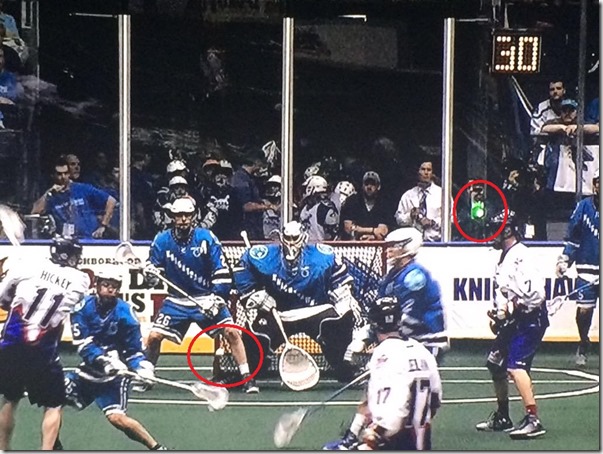On the Addicted to Lacrosse show this week, I picked the Rock to win Saturday night’s game because of what I saw last weekend. When the Rock hosted the Knighthawks in the division finals, they came out fired up in game 2, slowed down a touch in the second half, but then came out fired up again in the tiebreaker. They got to Matt Vinc, one of the best goaltenders anywhere, scored a bunch against one of the best defenses in the league, and kept Dan Dawson off the scoreboard (i.e. 0 goals). Any team that can do that, and has the motivation that the Rock has, will be hard to beat in the finals, especially at home. So they should win game 1.
Great logic, except it didn’t happen.
I don’t know what was said in the Rock dressing room before the Rochester game that got them so fired up (presumably it was more than just “let’s win it for T!”), but it didn’t work on Saturday night. They did come out looking pretty strong, scoring the first two goals and keeping the Rush offense from getting many decent shots, but the first two goals were the only ones in the quarter for the Rock. After Mark Matthews scored on the power play, the Rush were kept off the board for another 5 minutes before scoring 3 in under two minutes to take the lead. A fifth with under a minute left gave them a 3 goal lead at the end of the first quarter. I tweeted that the Rush were leading 7-3 at the end of the first quarter last week, and they lost. But last week they stopped playing as well as they did in the first, and the Calgary D stepped up. Neither of those things happened in this one.
The Rock weren’t terrible, mostly, but certainly not as strong as we saw last week. Miller was OK but wasn’t seeing the ball well. Rose replaced him in the second and again in the fourth and was better. The Rock D in general was also OK but had some serious lapses in judgement here and there. The Rush D, on the other hand, was stifling, and Aaron Bold was great. He was stopping almost everything from way out (that didn’t get blocked by a defender), and the Rush D wouldn’t let the Rock forwards get in close, so there was basically no way to score on him.
The Rock offense had their moments, some crisp passing and nice goals, but for the most part they were shut down by the Edmonton D. Continuing the trend that Rochester started in the semifinals, the Rush blocked an awful lot of shots. Edmonton’s forwards were generally good but holy cow, Mark Matthews was outstanding. The guy was everywhere – plowing through defenders like they weren’t there, and firing bullets at Miller or Rose. Robert Church had a good night, but I thought Jarrett Davis was very good as well. Davis was the Kasey Beirnes of the Rush: getting into the middle, setting picks, and getting pounded pretty good so that the big O guys (Matthews, Church, Greer, McIntosh) could get better looks at the net.
But the difference in the game was the transition. I couldn’t count the number of times the Rock would get a transition chance that turned into a 5 second possession after a bad shot through two defenders. Basically the Rush defense got out there so fast that the “chance” wasn’t much of a chance once they got near the net. Similarly, Rock forwards got caught on defense a lot because the Rush transition was so fast that there wasn’t time to change. Crowley isn’t bad on defense for a forward, and Josh Sanderson is a better defender at 38 than he used to be, but he’s still not great. But one of the Rush goals in the second half was scored with Sanderson, Hellyer, and Leblanc as three of the defenders. That’s just not their thing.
Game 2 goes next Friday in Edmonton and if the Rock play then like they played on Saturday, this one’s over and congrats to the Rush. But if they play like they played last week, then we’ll have a series.
Other game notes:
- Attendance was listed as 9257, or about a thousand less than last week. The difference looked and sounded like a lot more than a thousand.
- The Rock seemed to be dropping the ball a lot on offense. Not missed passes, and not (always) Rush defenders knocking the ball out of their stick, just plain dropping the ball.
- Kasey Beirnes’ first goal was nice but the pass was even better. Rob Hellyer was lining up to fire a shot until at the last possible moment he saw Beirnes open beside the net. He changed his shot into a pass to Beirnes who buried it. Nice unselfish play.
- Similarly, Mark Matthews made a beautiful pass in the third to a streaking Zack Greer who put it behind Rose (or Miller, don’t remember who was in at the time). The timing of the pass had to be perfect or Greer, who was being covered by a Rock defender, wouldn’t have gotten it. But it was perfect.
- Near the end of the game, when the comeback was still possible, the Rock kept losing their own possessions because of moving picks. C’mon guys, when every possession is that important, don’t waste them.









